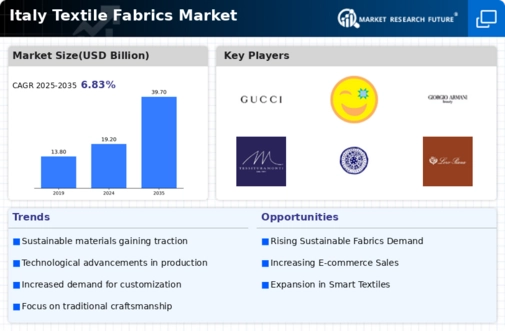The Italy Textile Fabrics Market is characterized by its rich heritage, craftsmanship, and innovation, serving as a global focal point for high-quality fabric production. This market is highly competitive, with numerous players vying for market share by leveraging their unique strengths and capabilities. The landscape is influenced by various factors including changing consumer preferences, trends in fashion, sustainability concerns, and advancements in textile technologies.
In this context, companies are continuously innovating their product offerings while also reinforcing their brand identities. The competitive insights within this sector highlight the importance of quality, exclusivity, and brand loyalty, with leading firms prioritizing sustainable practices and modern designs to appeal to a discerning clientele.Gucci has established itself as a prominent player in the Italy Textile Fabrics Market by capitalizing on its strong brand appeal and a commitment to luxury and quality. The company is known for its innovative designs and unique fabric choices, ensuring a position of strength in terms of market presence.
Gucci’s reputation is built on its ability to combine traditional craftsmanship with modern aesthetics, thus resonating with a broad spectrum of consumers. The brand’s focus on sustainability and ethical production practices has further enhanced its competitive edge, attracting a growing demographic that values environmental consciousness. The skilled artisans involved in the production process also add value to Gucci’s offerings, establishing a hallmark of Italian textile craftsmanship.Fratelli Tallia di Delfino stands as a distinguished name in the Italy Textile Fabrics Market, acclaimed for its fine wool and luxurious fabrics.
The company is recognized for its high-quality textiles that cater primarily to the upscale menswear segment, showcasing a blend of tradition and innovation. Its rich history of artistry in fabric production is complemented by state-of-the-art manufacturing techniques that enhance product quality. The strengths of Fratelli Tallia di Delfino lie in its diverse range of offerings, which include worsteds, cashmeres, and specialized blends tailored for bespoke tailoring. The company is also strategically positioned in the luxury market, strengthening its presence through collaborations with high-end fashion houses.
Recent mergers and acquisitions have only bolstered its market position, allowing Fratelli Tallia di Delfino to expand its footprint within Italy while maintaining a strong commitment to the artisanal heritage that defines its identity.



















Leave a Comment